|
|
Canku Ota |
|
|
(Many Paths) |
||
|
An Online Newsletter Celebrating Native America |
||
|
December 28December 15, 2001 - Issue 51 |
||
|
|
||
|
How Tol-le-loo Stole Fire |
||
|
Northern Mewuk Legend
|
||
|
|
|
Their neighbors to the east, the Mountain People, lived in darkness in the Sierra Nevada mountains. Although, they wanted fire, the Mountain People did not know where or how to obtain it. O-la-choo, the Coyote-man, tried to find it but failed. Eventually, Tol-le-loo, the White-footed Mouse, discovered that the Valley People had fire, and O-la-choo sent him to steal it.
When Wek-wek the Falcon awoke and saw the fire on Mount Diablo, he knew that Tol-le-loo had stolen the Valley People's fire. So he set out after Tol-le-loo, and eventually caught him. Tol-le-loo denied having taken the fire, and told Wek-wek to search him if he doubted him. Wek-wek searched but could not find the fire because it was inside Tol-le-loo's flute. So Wek-wek tossed Tol-le-loo into some water and let him go on his way.
Le-che-che the Hummingbird and another bird went after it, but they could not catch it and returned empty-handed.
The people took the fire that was left and put it into two trees, the buckeye and the incense cedar, where legend says it still resides. From that time on, the Mountain People made their fire drills from the wood of these two trees. Print and Color Your Own Picture of Tol-le-loo |
|
|
|
White-footed Mouse
(Peromyscus leucopus)
|
|||||
|
|||||
|
|
||
|
|
||
| Canku Ota is a free Newsletter celebrating Native America, its traditions and accomplishments . We do not provide subscriber or visitor names to anyone. Some articles presented in Canku Ota may contain copyright material. We have received appropriate permissions for republishing any articles. Material appearing here is distributed without profit or monetary gain to those who have expressed an interest. This is in accordance with Title 17 U.S.C. section 107. | ||
|
Canku Ota is a copyright © 2000, 2001, 2002 of Vicki Lockard and Paul Barry. |
||
 |
 |
|
|
The "Canku Ota - A Newsletter Celebrating Native America" web site and its design is the |
||
|
Copyright © 1999, 2000, 2001, 2002 of Paul C. Barry. |
||
|
All Rights Reserved. |
||
 Taking
his elderberry flute with him, Tol-le-loo travelled west until he reached
the homes of the Valley People. Arriving outside their roundhouse, Tol-le-loo
sat down and began to play his flute. Finding the music pleasant to
listen to, the Valley People invited Tol-le-loo to come inside and continue
his playing. Soon all the people began to feel sleepy. Now Wit-tah-bah
the Robin was pretty sure that Tol-le-loo was planning on stealing their
fire, so he spread himself over the embers to protect it. And that is
why the robin's is breast is red today.
Taking
his elderberry flute with him, Tol-le-loo travelled west until he reached
the homes of the Valley People. Arriving outside their roundhouse, Tol-le-loo
sat down and began to play his flute. Finding the music pleasant to
listen to, the Valley People invited Tol-le-loo to come inside and continue
his playing. Soon all the people began to feel sleepy. Now Wit-tah-bah
the Robin was pretty sure that Tol-le-loo was planning on stealing their
fire, so he spread himself over the embers to protect it. And that is
why the robin's is breast is red today.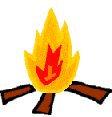 Tol-le-loo
kept playing his flute, and pretty soon everyone, including Wit-tah-bah
the Robin, had fallen asleep. Seizing this opportunity, Tol-le-loo ran
up to the sleeping Wit-tah-bah, and cut a small hole in his wing. Then
he crawled through the hole and placed the fire inside his flute. Running
out of the roundhouse, he climbed to the top of Mount Diablo, where
he built a great fire that lit up the entire countryside, including
the blue Sierra Nevada mountains to the east where the Mountain People
lived.
Tol-le-loo
kept playing his flute, and pretty soon everyone, including Wit-tah-bah
the Robin, had fallen asleep. Seizing this opportunity, Tol-le-loo ran
up to the sleeping Wit-tah-bah, and cut a small hole in his wing. Then
he crawled through the hole and placed the fire inside his flute. Running
out of the roundhouse, he climbed to the top of Mount Diablo, where
he built a great fire that lit up the entire countryside, including
the blue Sierra Nevada mountains to the east where the Mountain People
lived.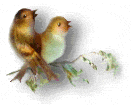 Tol-le-loo
climbed out of the water, and continued east to the mountains, all the
while carrying the fire in his flute. Arriving home, he took the fire
out of the flute, and placed it on the ground. Then covering it with
leaves and pine needles, he wrapped it up in a small bundle.
Tol-le-loo
climbed out of the water, and continued east to the mountains, all the
while carrying the fire in his flute. Arriving home, he took the fire
out of the flute, and placed it on the ground. Then covering it with
leaves and pine needles, he wrapped it up in a small bundle.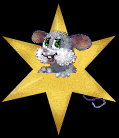 O-la-choo
the Coyote-man could smell the fire, and wanted to steal it. He approached
the bundle, and pushed it with his nose, preparing to swallow it. Suddenly,
however, the fire shot up into the sky and became the Sun.
O-la-choo
the Coyote-man could smell the fire, and wanted to steal it. He approached
the bundle, and pushed it with his nose, preparing to swallow it. Suddenly,
however, the fire shot up into the sky and became the Sun.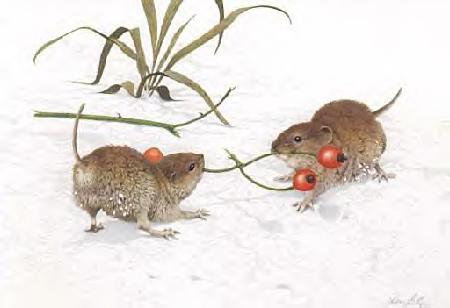 The
white-footed mouse is very similar to the deer mouse.. It is 16
to 20 cm long including a six to nearly ten cm long tail, and
weighs 10 to 43 g. It is greyish to dull orange-brown above and
white below with large ears. Young mice are more grey than their
parents. White-footed mice live in wooded or brushy areas in all
parts of Southern Ontario and southern Quebec, and American states
south to Texas and northern Georgia.
The
white-footed mouse is very similar to the deer mouse.. It is 16
to 20 cm long including a six to nearly ten cm long tail, and
weighs 10 to 43 g. It is greyish to dull orange-brown above and
white below with large ears. Young mice are more grey than their
parents. White-footed mice live in wooded or brushy areas in all
parts of Southern Ontario and southern Quebec, and American states
south to Texas and northern Georgia.  Like
the deer mouse, the white-footed mouse has several litters of
two to seven young each year. White-footed mice pair up to raise
their young. Females and males build nests in stumps, hollow trees
or burrow underground. Blind and hairless young are born about
three weeks after the mating. Each baby is about the size of a
jellybean. They immediately start to take milk from their mother
and grow rapidly. During the warm months, female white-footed
mice are ready to mate very soon after giving birth to a litter.
Like
the deer mouse, the white-footed mouse has several litters of
two to seven young each year. White-footed mice pair up to raise
their young. Females and males build nests in stumps, hollow trees
or burrow underground. Blind and hairless young are born about
three weeks after the mating. Each baby is about the size of a
jellybean. They immediately start to take milk from their mother
and grow rapidly. During the warm months, female white-footed
mice are ready to mate very soon after giving birth to a litter.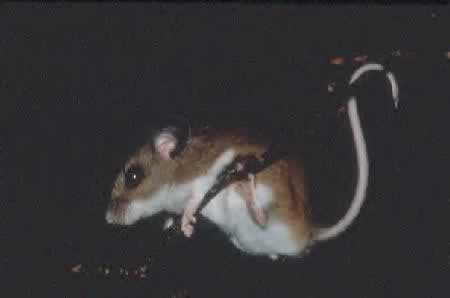 The
white-tailed mouse eats seeds from many kinds of grasses, acorns,
beechnuts, hickory, chestnuts, basswood, pine seeds, and cherry
seeds from inside the pits. The last is a real favourite. It also
eats berries, insects, mammals smaller than itself, young birds
in their nests, caterpillars, and snails.
The
white-tailed mouse eats seeds from many kinds of grasses, acorns,
beechnuts, hickory, chestnuts, basswood, pine seeds, and cherry
seeds from inside the pits. The last is a real favourite. It also
eats berries, insects, mammals smaller than itself, young birds
in their nests, caterpillars, and snails.